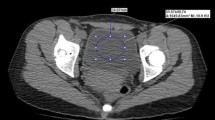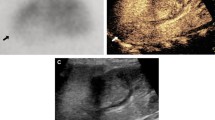Abstract
Purpose
To evaluate the predictive value of attenuation value (HU) in renal pelvis urine for detecting renal pelvis urine culture (RPUC) positivity in obstructed urinary systems.
Methods
The study group consisted of patients who had nephrostomy insertion performed because of obstructed system and suspicion of pyonephrosis and percutaneous nephrolithotomy (PCNL) patients who had obstructed calculi. Group 1 consisted of RPUC positive 28 patients during nephrostomy insertion or needle access in PCNL and group 2 consisted of 23 patients with negative RPUC. RPUC results and non-contrast computed tomography measurements [Hounsfield unit (HU)] were compared between group 1 and group 2. A cut-off value was determined for HU. All patients were grouped according to whether they were above or below this value.
Results
The median HU calculated from the renal pelvis was − 8.5 (range − 29/− 1) and 10 (range− 4/+ 17) (p < 0.001) in group 1 and group 2, respectively. The cut-off value of HU that predicted positive RPUC was 0. Sensitivity and specificity of HU when considering this cut-off value were 100% and 96%, respectively (p < 0.001). Whereas RPUC positivity was found in 96.6% (28/29) of patients with HU < 0, there were no patients with HU > 0 where RPUC positivity was detected (p < 0.001).
Conclusion
In this cohort, we found that HU of the urine in the renal pelvis can be used to predict RPUC positivity.




Similar content being viewed by others
References
Reyner K, Heffner AC, Karvetski CH (2016) Urinary obstruction is an important complicating factor in patients with septic shock due to urinary infection. Am J Emerg Med 34:694
Wagenlehner FM, Pilatz A, Weidner W (2011) Urosepsis—from the view of the urologist. Int J Antimicrob Agents 38:51–57
Hoffmann H, Schmoldt S, Trülzsch K, Stumpf A, Bengsch S, Blankenstein T et al (2005) A Nosocomial urosepsis caused by Enterobacter kobei with aberrant phenotype. Diagn Microbiol Infect Dis 53:143–147
Serniak PS, Denisov VK, Guba GB, Zakharov VV, Chernobrivtsev PA, Berko EM et al (1990) The diagnosis of urosepsis. Urol Nefrol 4:9–13
Brun-Buisson C (2000) The epidemiology of the systemic inflammatory response. Intensive Care Med 26:64–74
Brun-Buisson C, Doyon F, Carlet J (1996) Bacteremia and severe sepsis in adults: a multicenter prospective survey in ICUs and wards of 24 hospitals. French Bacteremia-Sepsis Study Group. Am J Respir Crit Care Med 154:617–624
Rangel-Frausto MS, Pittet D, Costigan M, Hwang T, Davis CS, Wenzel RP et al (1995) The natural history of the systemic inflammatory response syndrome (SIRS). A prospective study. JAMA 273:117–123
Sands KE, Bates DW, Lanken PN, Graman PS, Hibberd PL, Kahn KL et al (1997) Academic Medical Center Consortium Sepsis Project Working Group. Epidemiology of sepsis syndrome in 8 academic medical centers. JAMA 278:234–240
McDougall EM, Liatsikos EN, Dinlenc CZ, Smith AD (2002) Percutaneous approaches to the upper urinary tract. In: Walsh PC, Retik AB, Vaughan ED, Wein AJ (eds) Campbell’sUrology, 8th edn. W.B. Saunders Company, Philadelphia, pp 3327–3452
Basmaci I, Bozkurt IH, Sefik E, Celik S, Yarimoglu S, Degirmenci T (2018) A novel use of attenuation value (Hounsfield unit) in non-contrast CT: diagnosis of urinary tract infection. Int Urol Nephrol 50:1557–1562
Garcia LS, Isenberg HD (2010) Clinical Microbiology Procedures Handbook, 3rd edn. ASM Press, Washington DC
Kaplan DM, Rosenfield AT (1997) Smith RC Advances in the imaging of renal infection: helical CT and modern coordinated imaging. Infect Dis Clin North Am 11:681–705
Fultz PJ, Hampton WR (1993) Totterman SM Computed tomography of pyonephrosis. Abdom Imaging 18:82–87
Kawashima A, Sandler CM, Ernst RD, Goldman SM, Raval B, Fishman EK (1997) Renal inflammatory disease: the current role of CT. Crit Rev Diagn Imaging 38:369–415
Hounsfield GN (1980) Nobel lecture, 8 December 1979. Computed medical imaging. J Radiol 61:459–468
Zeb I, Li D, Nasir K, Katz R, Larijani VN, Budoff MJ (2012) Computed tomography scans in the evaluation of fatty liver disease in a population based study: the multi-ethnic study of atherosclerosis. Acad Radiol 19:811–818
Pickhardt PJ, Pooler BD, Lauder T, del Rio AM, Bruce RJ, Binkley N (2013) Opportunistic screening for osteoporosis using abdominal computed tomography scans obtained for other indications. Ann Intern Med 158:588–595
Bruni SG, Patafio FM, Dufton JA, Nolan RL (2013) Islam O The assessment of anemia from attenuation values of cranial venous drainage on unenhanced computed tomography of the head. Can Assoc Radiol J 64:46–50
Ouzaid I, Al-qahtani S, Dominique S, Hupertan V, Fernandez P, Hermieu JF et al (2012) A 970 Hounsfield units (HU) threshold of kidney stone density on non-contrast computed tomography (NCCT) improves patients’ selection for extracorporeal shockwave lithotripsy (ESWL): evidence from a prospective study. BJU Int 110:438–442
Mizumura N, Okumura S, Toyoda S, Imagawa A, Ogawa M, Kawasaki M (2016) Non-traumatic bladder rupture showing less than 10 Hounsfield units of ascites. Acute Med Surg 4:184–189
Yuruk E, Tuken M, Sulejman S, Colakerol A, Serefoglu EC, Sarica K (2017) Computerized tomography attenuation values can be used to differentiate hydronephrosis from pyonephrosis. World J Urol 35:437–442
Yuh BI, Cohan RH (1999) Different phases of renal enhancement: role in detecting and characterizing renal masses during helical CT. AJR Am J Roentgenol 173:747–755
Funding
None.
Author information
Authors and Affiliations
Corresponding author
Ethics declarations
Conflict of interest
Author Basmaci I declares that he has no conflict of interest. Author Sefik E declares that he has no conflict of interest.
Ethical approval
All procedures performed in studies involving human participants were in accordance with the ethical standards of the 1964 Helsinki declaration and its later amendments or comparable ethical standards.
Informed consent
Informed consent was obtained from all individual participants included in the study.
Additional information
Publisher's Note
Springer Nature remains neutral with regard to jurisdictional claims in published maps and institutional affiliations.
Rights and permissions
About this article
Cite this article
Basmaci, I., Sefik, E. A novel use of attenuation value (Hounsfield unit) in non-contrast CT: diagnosis of pyonephrosis in obstructed systems. Int Urol Nephrol 52, 9–14 (2020). https://doi.org/10.1007/s11255-019-02283-2
Received:
Accepted:
Published:
Issue Date:
DOI: https://doi.org/10.1007/s11255-019-02283-2




